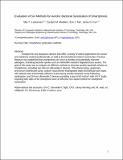Evaluation of 6 Methods for Aerobic Bacterial Sanitization of Smartphones
Author(s)
Lieberman, Mia; Madden, Carolyn; Ma, Eric Jinglong; Fox, James G
DownloadAccepted version (473.1Kb)
Terms of use
Metadata
Show full item recordAbstract
Smartphones are ubiquitous devices that offer a variety of useful applications for human and veterinary medical professionals and the biomedical research community. Smartphones can serve as fomites and potentially transmit pathogens, including bacterial species such as methicillin-resistant Staphylococcus aureus. The goal of this study was to evaluate 6 methods to decrease aerobic bacterial colonies on smartphones, including two 254-nm UVC devices, 70% ethanol spray, quaternary ammonium disinfectant spray, sodium hypochlorite-impregnated wipes, and delicate-task wipes. All methods were individually effective at decreasing aerobic bacterial counts after sanitization. In addition, 254-nm UVC devices providing a dose of 60 mJ/cm², with UVC bulbs exposing both sides of the smartphone, were an effective nonliquid method for smartphone sanitization.
Date issued
2018-01Department
Massachusetts Institute of Technology. Division of Comparative Medicine; Massachusetts Institute of Technology. Department of Biological EngineeringJournal
Journal of the American Association for Laboratory Animal Science
Publisher
American Association for Laboratory Animal Science (AALAS)
Citation
Lieberman, Mia T. et al. "Evaluation of 6 Methods for Aerobic Bacterial Sanitization of Smartphones." Journal of the American Association for Laboratory Animal Science 57, 1 (January 2018): 24-29 © 2018 American Association for Laboratory Animal Science (AALAS)
Version: Author's final manuscript
ISSN
1559-6109